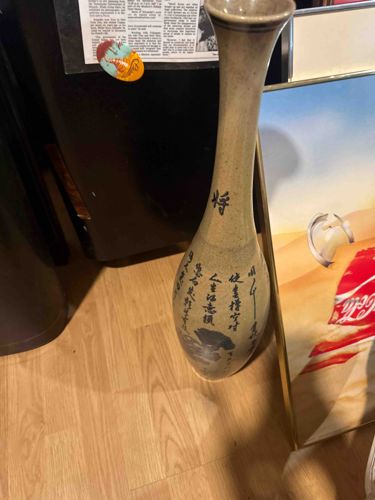
Asian-Inspired Ceramic Baluster Vase with Calligraphy and Landscape Motif
This item is a ceramic baluster-shaped vase, characterized by its tall, slender body that gradually widens towards the lower half and tapers again towards the base, topped with a flared or trumpet-shaped mouth. The vase appears to be made from a relatively coarse-grained ceramic material, possibly stoneware, with a matte or satin finish. The primary color is a muted, earthy beige or light brown, suggesting a naturalistic or 'tea dust' glaze, possibly with some speckling or variations in tone that add to its rustic aesthetic. The most prominent decorative features are the extensive black-ink calligraphy brushstrokes applied vertically along the upper and mid-sections of the body, indicating an Asian, likely Chinese or Japanese, origin or inspiration. Below the calligraphy, on the wider part of the vase, there is a hand-painted landscape motif in muted tones, primarily black, grey, and possibly dark blue, depicting what appears to be mountains, water, and perhaps some foliage or a structure in a classic East Asian ink wash style. One specific character, '将' (jiāng or jiàng, meaning general, commander, or will), is clearly visible on the upper half, distinct from the longer calligraphic passages. The overall craftsmanship appears to be folk art or studio pottery level, rather than mass-produced. There are no immediately visible cracks, chips, or significant repairs, but the matte surface may obscure minor wear or imperfections. The base is not visible, making it impossible to ascertain any maker's marks or signatures. Given the style of calligraphy and landscape, it likely dates from the 20th century, possibly mid to late. The unrefined clay and glaze suggest an emphasis on natural materials and traditional artistry.
AI-Generated Appraisal Disclaimer
Estimated Value
$200-400
Basic Information
Category
Decorative Arts - Ceramics
Appraised On
December 7, 2025
Estimated Value
$200-400
Item Description
This item is a ceramic baluster-shaped vase, characterized by its tall, slender body that gradually widens towards the lower half and tapers again towards the base, topped with a flared or trumpet-shaped mouth. The vase appears to be made from a relatively coarse-grained ceramic material, possibly stoneware, with a matte or satin finish. The primary color is a muted, earthy beige or light brown, suggesting a naturalistic or 'tea dust' glaze, possibly with some speckling or variations in tone that add to its rustic aesthetic. The most prominent decorative features are the extensive black-ink calligraphy brushstrokes applied vertically along the upper and mid-sections of the body, indicating an Asian, likely Chinese or Japanese, origin or inspiration. Below the calligraphy, on the wider part of the vase, there is a hand-painted landscape motif in muted tones, primarily black, grey, and possibly dark blue, depicting what appears to be mountains, water, and perhaps some foliage or a structure in a classic East Asian ink wash style. One specific character, '将' (jiāng or jiàng, meaning general, commander, or will), is clearly visible on the upper half, distinct from the longer calligraphic passages. The overall craftsmanship appears to be folk art or studio pottery level, rather than mass-produced. There are no immediately visible cracks, chips, or significant repairs, but the matte surface may obscure minor wear or imperfections. The base is not visible, making it impossible to ascertain any maker's marks or signatures. Given the style of calligraphy and landscape, it likely dates from the 20th century, possibly mid to late. The unrefined clay and glaze suggest an emphasis on natural materials and traditional artistry.
Related Tags
Get Your Items Appraised
Instant estimates of your treasures with AI-powered instant appraisals